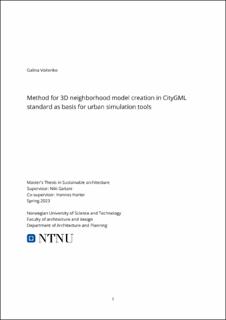| dc.description.abstract | As cities continue to expand, the availability of basic resources for constructing and maintaining comfortable living conditions in homes becomes increasingly limited. To create a sustainable urban environment, it is crucial to prioritize sustainable construction practices and minimize resource consumption.
Norway has established itself as a leading country in sustainability research, particularly in the construction and architecture sectors. To address the mentioned challenges in Norway, it is necessary to analyze the local building stock, both new projects and renovated, to develop optimization strategies. Evaluating buildings in terms of operational energy needs and conducting a life cycle assessment (LCA) of building technical services (TBS) can significantly contribute to achieving sustainability goals.
As of now, the application of these concepts has resulted in endeavors to utilize contemporary technologies, such as employing 3D city models. While 3D modelling can aid in planning and expedite decision-making, planners often hesitate to use them due to the complexities of data integration and the lack of an efficient building stock evaluation process.
This dissertation aims to promote spatial modelling for sustainable architecture, specifically at the district level, by creating a 3D model of the district and conducting a housing stock assessment using computer-aided urban tools.
The methodology will be illustrated through a case study of a district in Norway, the city of Fredrikstad, which encompasses two areas — one already existing development and the other planned for future development. The life cycle assessment process will rely on 3D city models developed in accordance with the CityGML standard. These models will be utilized in life cycle assessment software, incorporating relevant data specific to Norway. The results will be analyzed mainly in terms of operational energy demand, heat load, and LCA, which will be compared between the results of these two cases. For the newly developed areas, it will also be compared against similar calculations processed by syn.ikia project.
The outcome of this study will be a comprehensive methodology and recommendations for generating 3D models and assessing the building stock based on these models. Furthermore, the study demonstrates the methodology's ability to produce reliable results. It is worth noting that this dissertation does not explore the creation of alternative scenarios for the new developments, but this area presents an interesting potential for future research about reducing energy demand on a life cycle basis. | |
